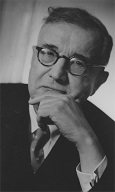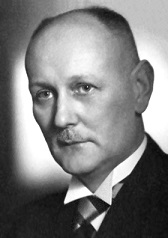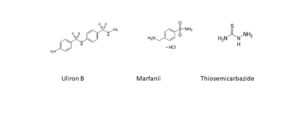We haven’t yet told the whole story about the sulfas in Germany during WW II. For further reading we recommend the book by John E. Lesch, already referred to: The First Miracle Drugs, How the sulfa drugs transformed medicine. In much detail, the author tells how endangered from many sides and careful, main characters of the sulfa development like Hörlein and Domagk have to manoeuvre, in order to be able to carry on their work.
Project ‘100 years of antibiotics’
Episode 7. Aspirin
Episode 8. The success of the sulfas; with a black rim
Episode 9. In the crossfire
Episode 10. International recognition
Episode 11. Pride comes before a fall

Domagk and Hörlein
At times, researchers run into very dangerous situations. Here we tell the story of two main protagonists: Gerhard Domagk and his superior Heinrich Hörlein. Domagk is the principal discoverer of the first sulfa, Prontosil. Hörlein is a member of the Board of IG Farben, and the spider in the web on the crossroad of chemistry and medicines in entire Germany. In 1911, Hörlein is appointed the successor to Arthur Eichengrün (see # 6) as the head of Bayer’s pharmaceutical laboratories.

After having received the Nobel Prize in 1939, Domagk writes an enthusiastic letter of thanks to the Nobel Prize Committee in Stockholm. The press gets wind of it, and a few weeks later Domagk is taken capture. He is forced to write a second letter, in which he renounces the Nobel Prize. He is allowed to continue his research, but only under strict surveillance. The Nazis instruct him to keep secret his results as much as possible, and restrict his freedom of research. Domagk cannot really stomach it. He protests, orally and in writing. In the lab, work becomes more difficult all the time during the war years. Personnel is forced into active service, and those who leave are replaced by others ever less qualified. The number of staff halves. A shortage of mice becomes a major threat to research. Safety and hygiene deteriorate. People start being infected with the bacteria they research. On June 24 and 25 1943, the installations of IG Farben in Elberfeld are bombed by allied forces. Domagk’s laboratories don’t receive much damage: just broken windows. But during the liberation in 1945 work really comes to a standstill for a few months.

Successes
In the meantime, Prontosil’s success dawns on doctors. Death rates fall spectacularly, especially in the treatment of pneumonia and epidemic meningitis. Two new sulfas are introduced on the market: Uliron in 1938 and Marfanil in 1941. Slowly, doctors start to be more successful even in the treatment of tuberculosis; the start of a new class of medicines, like thiosemicarbazide. The tuberculosis bacillus is particularly hard to beat. Initial success with sulfas is mostly followed by disappointment. Doctors have to wait until 1950 before a powerful medicine comes to the market. Uliron is very effective in the treatment of gonorrhoea and Marfanil in the control of gangrene resulting from gas attacks. Of course, both conditions having a major relationship to warfare. Sales go perfectly as well. From 1940 to 1945, IG Farben’s sales of Prontosil, Uliron and Marfanil amount to more than 60 million marks; profit being 26 million. Shipments of Marfanil to the army amount up to 10 tons monthly, for the treatment of injuries.
International work on sulfas also progresses well, facilitated by the expiration of the patent on sulphanilamide (see # 6). In its edition of January 28, 1939, the Dutch Medical Journal estimates the number of different sulfa molecules synthesized so far to run in several thousand already. Researchers discover that the substitutes in the benzene ring should preferably be located in the para position. As long as he can, Domagk continues to publish and to participate in international discussions. Gradually during the war, he publishes less often, but he resumes these activities very quickly after the war. In 1947, he is finally handed his Nobel Prize and then gives a well thought-out lecture on all his work on sulfas including his latest results. But he misses out on the concomitant remuneration (see # 1). After the war, he continues his career at Bayer, researching medicines against tuberculosis and cancer. He ends his career as a professor in Münster and dies at the age of 68 in 1964.
The Nuremberg IG Farben trial
For Heinrich Hörlein, all goes well in the end too, but he has to go through a very difficult period. It appears that it was calculation to become a member of the NSDAP. And even to become a city counsellor. He realizes, as becomes clear in retrospect, that he needs to sustain a network of this sort in order to be able to continue his important work of developing medicines on the basis of modern chemistry. In time, he succeeds in supplying to the American branch of IG Farben, Winthrop Chemical Company, important information on the production of sulfas like Prontosil. Representation of the interest of medicine development through chemical synthesis carries him to contacts with high German officials; including Hitler. He has to plea with all sorts of military authorities for almost all applications, patents, publications and the like. The authorities tend to prefer strict secrecy, opportunities for warfare being first and foremost on their minds.
The IG Farben process in Nuremberg, August 14, 1947 till July 30, 1948, becomes the ‘moment’ of truth. The officials have been in protective custody for two years, but now finally interrogation begins. IG Farben has a very bad reputation as a supplier to the Nazi regime, including supply of the infamous Zyklon B to exterminations camps like Auschwitz. There is a relationship between the start of nerve gases Tabun and Sarin development, and laboratories under Hörlein’s responsibility. But all testimonies on him turn out to be exculpatory. These are given by doctors, from abroad (for instance by the Pasteur Institute and the Winthrop Corporation), and by academics (like Max Planck). Exculpatory testimonies are also given by people from Jewish descent that have survived the war because of Hörlein’s intervention, or whom he helped to flee out of the country in time. Hörlein is acquitted. He returns to Bayer in Leverkusen and becomes a member to the Board. In 1952, he receives an honorary doctorate from the University of Darmstadt. He passes away in 1954, in the age of 71 years.
Sources:
Wikipedia: all names and products mentioned
The First Miracle Drugs, How the sulfa drugs transformed medicine, John E. Lesch. Oxford University Press, 2007
Gerhard Domagk, Further progress in chemotherapy of bacterial infections, Nobel Lecture, December 12, 1947
No-nonsense guide to Antibiotics. Moira Dolan, SmartMedinfo, 2015
Nederlands Tijdschrift voor Geneeskunde, 1938, 1939

Hello Professor Bruggink:
And thanks very much for posting this information about Hoerlein.
Maybe you could shed some more light on him? I’ve been reading The Devil’s Chemists, the book that Joe DuBois wrote about the 1947-48 trial of IG Farben’s leaders. DuBois headed up the prosecution team at the trial. (I’m studying this book, and others, for a writing project.)
In his book, DuBois mentions more than once that Hoerlein worked at the Farben/Bayer pharmaceutical laboratory in Elberfeld. He writes about: “the giant Leverkusen factory that sprawled along the Rhine within view of his Elberfeld laboratory window” (page 124 in the 1952 Beacon Press edition). But Elberfeld is part of the city of Wuppertal, at least half an hour’s drive from Leverkusen. It’s definitely not within view of the Rhine.
Does the information that’s available to you show that Hoerlein worked at Elberfeld, and not at Leverkusen?
The reason for this question is that I’m troubled by the many mistakes in The Devil’s Chemists. The ones I’ve noted so far don’t do serious damage to his thesis that although much of IG Farben’s pre-1933 work had great benefits, many of its senior people were war criminals from 1937 on. But DuBois had a reputation not only as a person who was deeply outraged by injustice, but also as an extremely orderly- and precise-minded thinker. In her book Rescue Board, Rebecca Erbelding alludes to his concern that documents be worded as exactly and accurately as possible. It’s hard to reconcile this reputation with the mistakes that pepper his book. Since it’s still the most widely cited eyewitness account of the IG Farben trial, its credibility is important.
He used a ghostwriter, Ed Johnson, who may not have travelled to Europe for research on the book. This possibly explains how the mistakes crept into the text, along with the fact that DuBois had no time to write it himself. (He mentioned this in the oral history interview he gave for to Truman Library in 1973.) I sincerely hope that the explanation is as innocent as this.
I’m sorry that I can’t check out this area of the Rhineland in person at present. I visited Leverkusen and Ludwigshafen some years ago, but neglected to include Wuppertal during the trip, unfortunately; it wasn’t on my radar screen at the time. I’m in Canada, and COVID makes travel to Europe an ongoing challenge. So I appreciate any light that you or your students can shed on this.
And no rush. I’m unlikely to have a completed manuscript much before this coming Christmas.
Again, many thanks for any help that you or your students can provide.
Joe Crozier